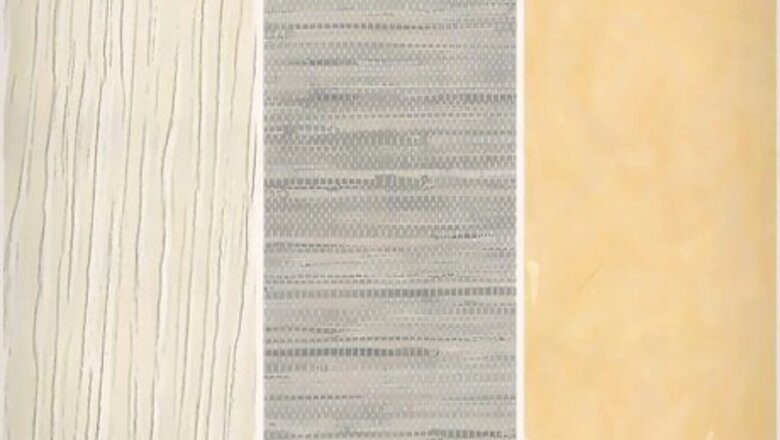
views
Cleaning Your Wallpaper
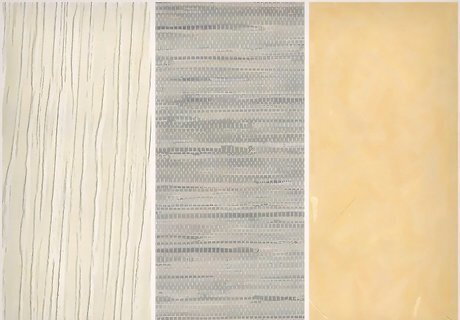
Determine your wallpaper type. Figure out what kind of wallpaper you have on your walls. Vinyl wallpaper is not difficult to clean. Coated fabric wallpaper is sometimes covered with an acrylic or vinyl covering that is easily washable. Plain paper wallpaper should not get wet. If possible, you should spot-clean it. You can scrub vinyl wallpaper, but you need to make sure that you don’t clean with anything abrasive. You wouldn’t want to use a rough sponge, for example. Clean walls that don’t have protective coating with a dry sponge. A dry sponge, which contains no moisture, gently gets rid of the dirt on your wallpaper. EXPERT TIP Filip Boksa Filip Boksa House Cleaning Professional Filip Boksa is a House Cleaning Professional and the CEO and Founder of King of Maids, a company based in Chicago, Illinois. With over 10 years of professional experience, Filip and his team at King Maids specialize in providing home cleaning and organization services to their clients. They are dedicated to delivering high-quality and reliable service to ensure customer satisfaction. Filip Boksa Filip Boksa House Cleaning Professional How you clean depends on the type of wallpaper you have. Semi-gloss and glossy finish is easy to clean, but you should avoid using liquids on wallpaper that feels more porous like a brown paper bag. You can clean most modern paper with a dampened sponge and multipurpose cleaner. Start at the top and work downwards. Make sure your sponge is not over saturated.
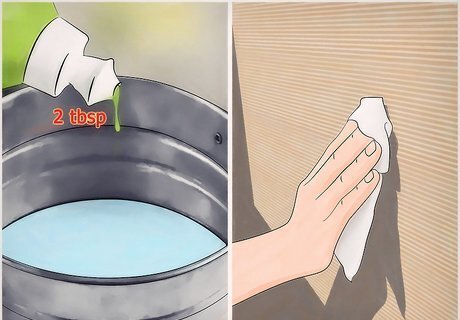
Clean the wallpaper. Mix a small amount of dish soap, about two table spoons worth, with warm water in a bucket. Use clear soap to avoid staining the wallpaper with colored detergent. Dip a soft cloth or sponge in the cleaning solution. Wring out the excess cleaner into the bucket. Test the cleaning solution by dabbing a bit of it on an inconspicuous area. If it doesn’t damage the wallpaper, start the cleaning process. Wipe the surface from the top to the bottom. Clean in the direction of the vertical seams. Clean one section at a time in a circular motion. Don’t overuse soap. Using a large amount of soap will make dirt stick to walls. You may not want to use scrubbing pads because they are usually too harsh for wallpaper Testing the cleaning solution in a small, hidden area prevents you from damaging the entire wall in case the cleaner turns out to be destructive. The surface near the baseboards is rarely noticeable to others, and is a good spot to test. EXPERT TIP Susan Stocker Susan Stocker Green Cleaning Expert Susan Stocker runs and owns Susan’s Green Cleaning, the #1 Green Cleaning Company in Seattle. She is well known in the region for outstanding customer service protocols — winning the 2017 Better Business Torch Award for Ethics & Integrity —and her energetic support of green cleaning practices. Susan Stocker Susan Stocker Green Cleaning Expert Make sure to wring out your cloth very well to avoid saturating the wallpaper. Water can cause the glue on wallpaper to fail. In addition, older wallpaper can disintegrate very easily, and water can hasten that deterioration. Use a microfiber cloth that's just moistened with water and gently rub the paper. If you have tough stains caused by dirt or oils, you can add a small amount of dish soap to the water used to wet your cloth.

Rinse and dry the wallpaper. This is where the second bucket comes in. Using the water from that bucket and a new cloth, rinse each section with clean water. Don’t use too much water; you don’t want to end up with damp walls. With a terry-cloth towel, dry the surface immediately after to prevent the wallpaper from soaking up too much moisture and tearing.
Dusting Your Wallpaper

Use a vacuum cleaner. The most efficient method for removing dust from your walls is vacuuming. Attach a wall brush extension to your vacuum before you start. Depending on the length of your extension, you may want to use a ladder to reach the higher spots of your wall. This extension will keep you from scratching your walls. Begin at the top of the wall and do a few sections at a time. Gently brush until you have completed the entire wall. As long as you don’t rub your vacuum on the wallpaper, you can generally use the vacuum on fabric wallpaper.

Dust with a broom. Find a cloth, preferably a micro fiber dusting cloth, and put it over a broom. Swipe the broom over the wall from left to right. This method will help you reach the dusty corners of your walls. Move the broom, clearing dust as you go, from the top of the wall to the bottom. You want to make sure that you leave no surface untouched. If dust builds up on the floor, sweep it up.
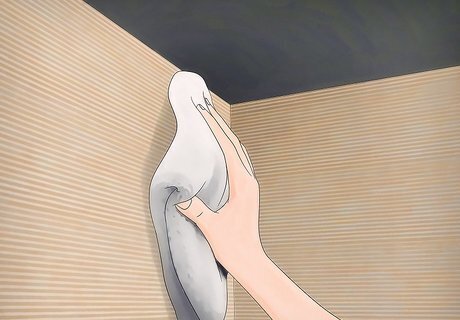
Dust with a cloth. Wipe the walls directly with it. If your walls are high, you may want to get a step ladder in order to reach the corners. Start at the top and clear off the dust that you see. As you move down, make sure that your cloth has not become too dirty. A dirty cloth will smudge your walls.
Removing Stains
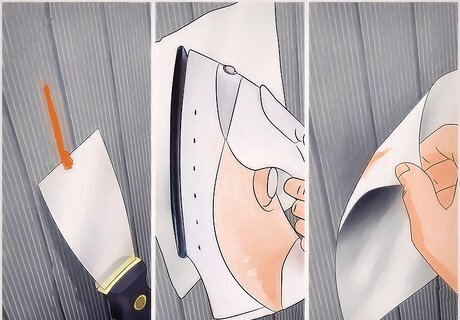
Remove crayon marks. Use a putty knife and scrape away the excess crayon. Any loose bits that stick out should be ripped away. Once the surface is cleared, place paper towels over the stain. Now, press an iron set to its lowest heat on top of the stain. Wait for a minute, until the residual crayon seeps into the towels. Remove the towels and the stain should come off. If you have washable wallpaper, then you should spray a washcloth with the solution you used to clean the walls. Then, gently wipe the stains until they disappear.

Remove finger prints. Find an art gum eraser. With this eraser, gently rub at the wall. The eraser should absorb the oil and dirt left by fingerprints. If you have vinyl wallpaper, you can use soap and water to wash these prints away. Create a dish soap and water solution in a bowl. Put a cloth into the bowl to wet it. Then, use the cloth to wash the prints off the wall. You can use a piece of bread to clear the wall. Take a piece of bread and leave it on the prints for a minute. Then, remove the bread from the wall. The gluten in the bread should remove the stains from the wallpaper.
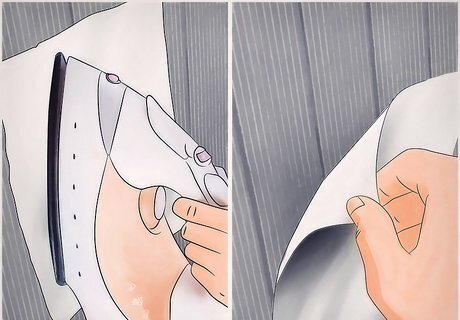
Remove grease spots. First, place paper towels over stains. Run an iron on a low heat setting over the paper towels. The grease should seep into the paper towels. Remove the towels to dislodge the stains. Talcum powder can also work. Pour talcum powder on a washcloth. Apply talcum powder onto the wall with the cloth. Let the powder sit for 10 minutes. Remove the powder from the wall with a dry sponge or brush.
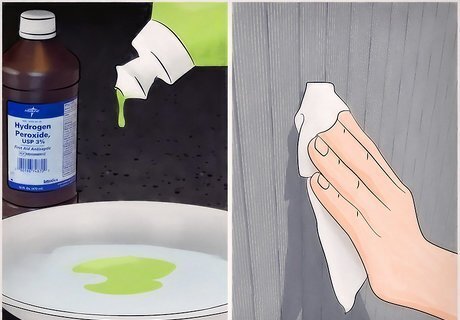
Remove red wine stains. Wet a rag with dish soap and peroxide. Using the rag, apply this combination to the wall. The combination should stick to stain. Leave it there for five minutes. Use a damp towel to wipe off the stain, then dry the area with a paper towel. If this does not work, then you can attempt to get rid of the stain with sodium percarbonate cleaner that will whiten the spot. Dip a rag into this cleaner and then put it on the stain for four to six minutes. Then remove the rag, the stain should be gone. With a wet clean cloth or towel, clear the spot. Dry the spot afterwards by patting at it with a dry cloth.













Comments
0 comment